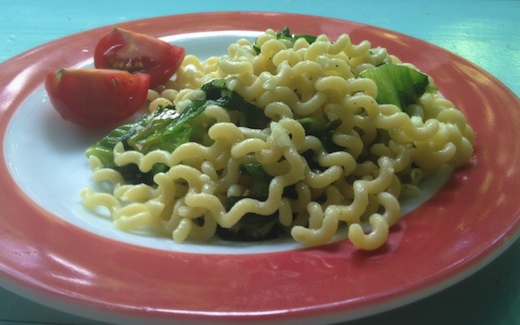Makes 6 servings
- ¼ cup pinenuts
- ½ cup olive oil
- 2 cloves garlic, thinly sliced
- 1 large head escarole (see notes)
- 1 lb Fusilli col buco (see notes)
- ¾ cup grated Romano
- ½ teaspoon freshly ground black papper
Special equipment
- none
Method
- While you’re waiting for your pasta water to come to a boil, toast the pinenuts in a large, dry frying pan. Reserve.
Cook garlic slices in the olive oil over low heat until golden.
Cut escarole into ½-¾ inch strops, discarding the bitter white ends. Rinse thoroughly.
Toss in the pan to coat with the garlic oil, cover, and turn up the heat to medium high. Cook until the greens have just wilted.
Toss the wilted greens and oil into the pasta. Stir in the grated cheese, pinenuts and pepper
Notes
- Fusilli col buco, literally ‘fusilli with a hole’, also known as long fusilli, is a pasta that’s long like spaghetti, hollow like macaroni, and curly like common short fusilli, perfect for capturing wilted greens. It’s worth the effort to find a long twisted pasta, but if you cannot, substitute something dense and curly, maybe short fusilli or rotini or cellentani, just don’ use something long, thin and straight. By using something thin instead of dense, you’ll upset the proportion of leaf to pasta.
Don’t bother to rinse the escarole ahead of time: while not as soil-laden as leaks, escarole is impossible to clean without separating the leaves. We’ll save ourselves the effort and rinse them after we’ve sliced them.↩
This dish is an exercise in reuse of equipment without cleaning: use the same frying pan in which you toasted the pinenuts for your sauce; use the same colander in which you rinsed your escarole to drain your pasta.

